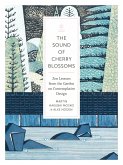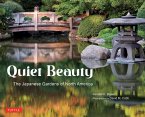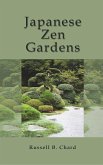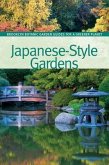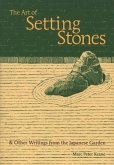Marc Peter Keane
The Japanese Tea Garden
Marc Peter Keane
The Japanese Tea Garden
- Broschiertes Buch
- Merkliste
- Auf die Merkliste
- Bewerten Bewerten
- Teilen
- Produkt teilen
- Produkterinnerung
- Produkterinnerung
"Impeccably written, erudite . . . likely to remain the standard work on the subject."Kyoto Journal
Andere Kunden interessierten sich auch für
![The Art of the Japanese Garden The Art of the Japanese Garden]() David YoungThe Art of the Japanese Garden27,99 €
David YoungThe Art of the Japanese Garden27,99 €![Sakuteiki: Visions of the Japanese Garden Sakuteiki: Visions of the Japanese Garden]() Jiro TakeiSakuteiki: Visions of the Japanese Garden17,99 €
Jiro TakeiSakuteiki: Visions of the Japanese Garden17,99 €![The Sound of Cherry Blossoms The Sound of Cherry Blossoms]() Alxe NodenThe Sound of Cherry Blossoms17,99 €
Alxe NodenThe Sound of Cherry Blossoms17,99 €![Quiet Beauty Quiet Beauty]() Kendall H. BrownQuiet Beauty22,99 €
Kendall H. BrownQuiet Beauty22,99 €![Japanese Zen Gardens Japanese Zen Gardens]() Russell ChardJapanese Zen Gardens10,99 €
Russell ChardJapanese Zen Gardens10,99 €![Japanese-Style Gardens Japanese-Style Gardens]() Japanese-Style Gardens13,99 €
Japanese-Style Gardens13,99 €![The Art of Setting Stones The Art of Setting Stones]() Marc Peter KeaneThe Art of Setting Stones16,99 €
Marc Peter KeaneThe Art of Setting Stones16,99 €-
-
-
"Impeccably written, erudite . . . likely to remain the standard work on the subject."Kyoto Journal
Hinweis: Dieser Artikel kann nur an eine deutsche Lieferadresse ausgeliefert werden.
Hinweis: Dieser Artikel kann nur an eine deutsche Lieferadresse ausgeliefert werden.
Produktdetails
- Produktdetails
- Verlag: Stone Bridge Press
- Seitenzahl: 296
- Erscheinungstermin: 15. April 2014
- Englisch
- Abmessung: 253mm x 205mm x 25mm
- Gewicht: 960g
- ISBN-13: 9781611720150
- ISBN-10: 161172015X
- Artikelnr.: 39409345
- Herstellerkennzeichnung
- Libri GmbH
- Europaallee 1
- 36244 Bad Hersfeld
- gpsr@libri.de
- Verlag: Stone Bridge Press
- Seitenzahl: 296
- Erscheinungstermin: 15. April 2014
- Englisch
- Abmessung: 253mm x 205mm x 25mm
- Gewicht: 960g
- ISBN-13: 9781611720150
- ISBN-10: 161172015X
- Artikelnr.: 39409345
- Herstellerkennzeichnung
- Libri GmbH
- Europaallee 1
- 36244 Bad Hersfeld
- gpsr@libri.de
Marc Peter Keane, a graduate of Cornell University, is an American landscape architect and author. He lived in Kyoto, Japan, for nearly 20 years, and specializes in Japanese garden design. Presently, he maintains a design office in Ithaca, New York. He is the author of several books about garden design: Japanese Garden Design (an introduction to the culture and design of Japanese gardens); Sakuteiki: Visions of the Japanese Garden (a translation of Japan's oldest gardening text, co-authored with Prof. Jiro Takei), The Art of Setting Stones (a collection of philosophical essays on gardens), and The Japanese Tea Garden (history and aesthetics of Japanese tea gardens). Keane has worked as a lecturer in the Department of Environmental Design at the Kyoto University of Art and Design and at Cornell University, and is a fellow at the Research Center for Japanese Garden Art, Kyoto, Japan, and the Institute for Medieval Japanese Studies, New York. He has lectured widely throughout the United States, England, and Japan. Keane also acted as chairman of Kyoto Mitate International for many years, a non-profit organization that worked to revitalize Kyoto's traditional environments and cultural heritage.
Acknowledgments ii
An Invitation to Tea x
1 a brief history of tea 1
Tang-Dynasty China (618-907) 3
Nara-Period Japan (710-84) 4
Song-Dynasty China (960-1279) 5
Kamakura-Period Japan (1185-1333) 9
Yuan-Dynasty China (1271-1368) 12
Ming-Dynasty China (1368-1644) 12
2 cultural background 19
Garden History 20
Machiya: Merchant Townhouses 23
The Hermit in the City 27
Tea Aesthetics 39
3 muromachi society 43
Bushi: Military Aristocracy 44
Zenso: Buddhist Priests 49
Shonin: Merchants 57
Shokunin/Geinosha: Artisans/Artists 63
4 early development of the roji 67
Early Development of the Tea Garden 68
Shuko: The Tea of Urban Merchants in the Late 15th Century 70
Joo: Wabi and Tea in the Early 16th Century 78
Rikyu: The Creation of the Tea Garden During the Late 16th Century 85
5 from roji to chaniwa: tea gardens in the edo period 117
The Word Roji 118
Tea Gardens in the Early Edo Period 120
Early 17th Century: Furuta Oribe and the Beginnings of Daimyo-cha 120
Mid-17th Century: Kobori Enshu and the Development of Daimyo-cha 133
Late Edo Period: The Codification of Tea Gardens 139
6 extant tea gardens and gardens influenced by tea 57
The Roji of Tea Grand Masters 158
Estate Gardens of Provincial Lords 165
Imperial Gardens 172
Gardens of Merchant Residences 179
20th-Century Private Estates 184
Other Private Residences 189
7 parts of a tea garden 197
Outer Gate: Soto-mon or Roji-mon 198
Tea Path: Roji Michi 201
The Waiting Bench: Koshikake 208
The Middle Gate: Chumon 211
The Water Basin: Tsukubai 216
Stone Lanterns: Ishi-doro 224
Dust Pit: Chiri-ana 225
Privy: Setchin 227
Fences: Kakine 227
Walls: Kabe 232
Garden Well: Ido 232
The Plantings: Ueki 233
Notes 243
Tea Text Summaries 261
Glossary of Garden Terminology 268
Bibliography 276
Index 281
An Invitation to Tea x
1 a brief history of tea 1
Tang-Dynasty China (618-907) 3
Nara-Period Japan (710-84) 4
Song-Dynasty China (960-1279) 5
Kamakura-Period Japan (1185-1333) 9
Yuan-Dynasty China (1271-1368) 12
Ming-Dynasty China (1368-1644) 12
2 cultural background 19
Garden History 20
Machiya: Merchant Townhouses 23
The Hermit in the City 27
Tea Aesthetics 39
3 muromachi society 43
Bushi: Military Aristocracy 44
Zenso: Buddhist Priests 49
Shonin: Merchants 57
Shokunin/Geinosha: Artisans/Artists 63
4 early development of the roji 67
Early Development of the Tea Garden 68
Shuko: The Tea of Urban Merchants in the Late 15th Century 70
Joo: Wabi and Tea in the Early 16th Century 78
Rikyu: The Creation of the Tea Garden During the Late 16th Century 85
5 from roji to chaniwa: tea gardens in the edo period 117
The Word Roji 118
Tea Gardens in the Early Edo Period 120
Early 17th Century: Furuta Oribe and the Beginnings of Daimyo-cha 120
Mid-17th Century: Kobori Enshu and the Development of Daimyo-cha 133
Late Edo Period: The Codification of Tea Gardens 139
6 extant tea gardens and gardens influenced by tea 57
The Roji of Tea Grand Masters 158
Estate Gardens of Provincial Lords 165
Imperial Gardens 172
Gardens of Merchant Residences 179
20th-Century Private Estates 184
Other Private Residences 189
7 parts of a tea garden 197
Outer Gate: Soto-mon or Roji-mon 198
Tea Path: Roji Michi 201
The Waiting Bench: Koshikake 208
The Middle Gate: Chumon 211
The Water Basin: Tsukubai 216
Stone Lanterns: Ishi-doro 224
Dust Pit: Chiri-ana 225
Privy: Setchin 227
Fences: Kakine 227
Walls: Kabe 232
Garden Well: Ido 232
The Plantings: Ueki 233
Notes 243
Tea Text Summaries 261
Glossary of Garden Terminology 268
Bibliography 276
Index 281
Acknowledgments ii
An Invitation to Tea x
1 a brief history of tea 1
Tang-Dynasty China (618-907) 3
Nara-Period Japan (710-84) 4
Song-Dynasty China (960-1279) 5
Kamakura-Period Japan (1185-1333) 9
Yuan-Dynasty China (1271-1368) 12
Ming-Dynasty China (1368-1644) 12
2 cultural background 19
Garden History 20
Machiya: Merchant Townhouses 23
The Hermit in the City 27
Tea Aesthetics 39
3 muromachi society 43
Bushi: Military Aristocracy 44
Zenso: Buddhist Priests 49
Shonin: Merchants 57
Shokunin/Geinosha: Artisans/Artists 63
4 early development of the roji 67
Early Development of the Tea Garden 68
Shuko: The Tea of Urban Merchants in the Late 15th Century 70
Joo: Wabi and Tea in the Early 16th Century 78
Rikyu: The Creation of the Tea Garden During the Late 16th Century 85
5 from roji to chaniwa: tea gardens in the edo period 117
The Word Roji 118
Tea Gardens in the Early Edo Period 120
Early 17th Century: Furuta Oribe and the Beginnings of Daimyo-cha 120
Mid-17th Century: Kobori Enshu and the Development of Daimyo-cha 133
Late Edo Period: The Codification of Tea Gardens 139
6 extant tea gardens and gardens influenced by tea 57
The Roji of Tea Grand Masters 158
Estate Gardens of Provincial Lords 165
Imperial Gardens 172
Gardens of Merchant Residences 179
20th-Century Private Estates 184
Other Private Residences 189
7 parts of a tea garden 197
Outer Gate: Soto-mon or Roji-mon 198
Tea Path: Roji Michi 201
The Waiting Bench: Koshikake 208
The Middle Gate: Chumon 211
The Water Basin: Tsukubai 216
Stone Lanterns: Ishi-doro 224
Dust Pit: Chiri-ana 225
Privy: Setchin 227
Fences: Kakine 227
Walls: Kabe 232
Garden Well: Ido 232
The Plantings: Ueki 233
Notes 243
Tea Text Summaries 261
Glossary of Garden Terminology 268
Bibliography 276
Index 281
An Invitation to Tea x
1 a brief history of tea 1
Tang-Dynasty China (618-907) 3
Nara-Period Japan (710-84) 4
Song-Dynasty China (960-1279) 5
Kamakura-Period Japan (1185-1333) 9
Yuan-Dynasty China (1271-1368) 12
Ming-Dynasty China (1368-1644) 12
2 cultural background 19
Garden History 20
Machiya: Merchant Townhouses 23
The Hermit in the City 27
Tea Aesthetics 39
3 muromachi society 43
Bushi: Military Aristocracy 44
Zenso: Buddhist Priests 49
Shonin: Merchants 57
Shokunin/Geinosha: Artisans/Artists 63
4 early development of the roji 67
Early Development of the Tea Garden 68
Shuko: The Tea of Urban Merchants in the Late 15th Century 70
Joo: Wabi and Tea in the Early 16th Century 78
Rikyu: The Creation of the Tea Garden During the Late 16th Century 85
5 from roji to chaniwa: tea gardens in the edo period 117
The Word Roji 118
Tea Gardens in the Early Edo Period 120
Early 17th Century: Furuta Oribe and the Beginnings of Daimyo-cha 120
Mid-17th Century: Kobori Enshu and the Development of Daimyo-cha 133
Late Edo Period: The Codification of Tea Gardens 139
6 extant tea gardens and gardens influenced by tea 57
The Roji of Tea Grand Masters 158
Estate Gardens of Provincial Lords 165
Imperial Gardens 172
Gardens of Merchant Residences 179
20th-Century Private Estates 184
Other Private Residences 189
7 parts of a tea garden 197
Outer Gate: Soto-mon or Roji-mon 198
Tea Path: Roji Michi 201
The Waiting Bench: Koshikake 208
The Middle Gate: Chumon 211
The Water Basin: Tsukubai 216
Stone Lanterns: Ishi-doro 224
Dust Pit: Chiri-ana 225
Privy: Setchin 227
Fences: Kakine 227
Walls: Kabe 232
Garden Well: Ido 232
The Plantings: Ueki 233
Notes 243
Tea Text Summaries 261
Glossary of Garden Terminology 268
Bibliography 276
Index 281




